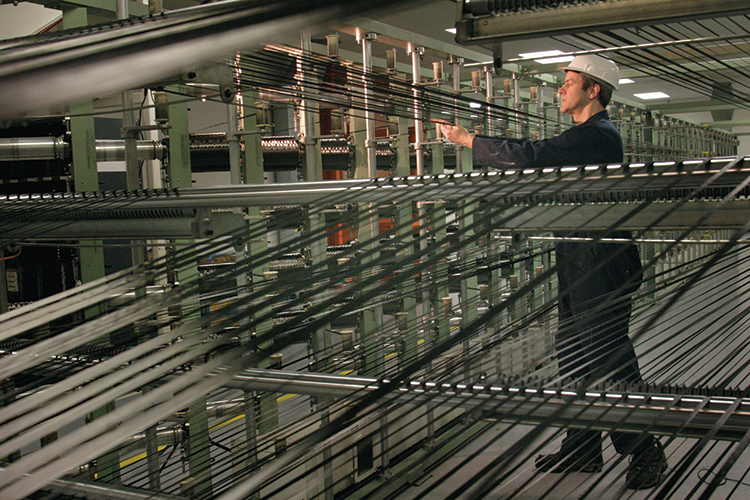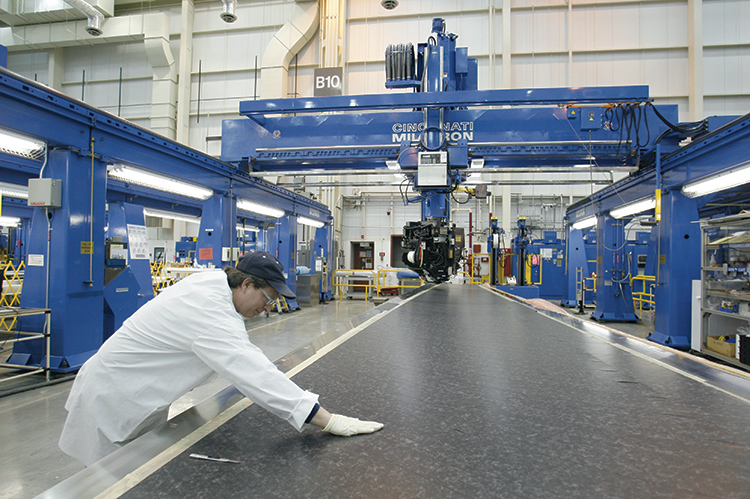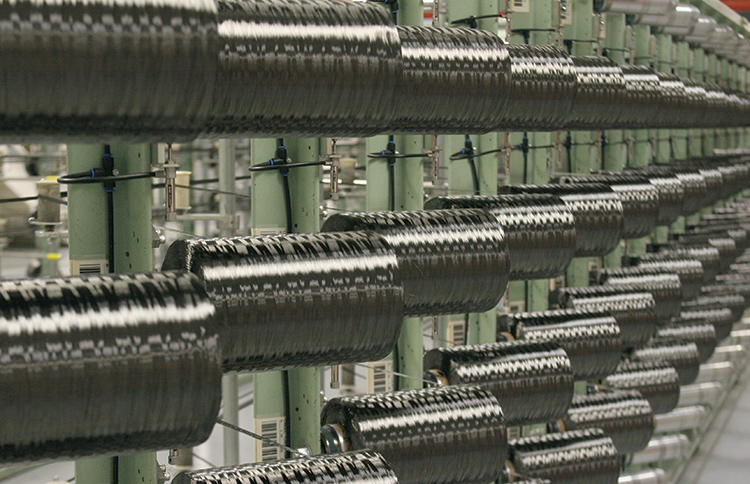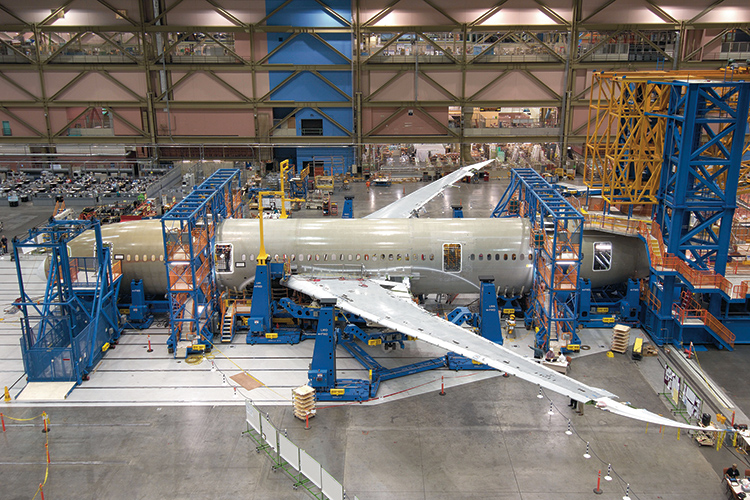With Boeing 787, UW has a hand in revolutionizing aviation
With orders from 47 airlines—and counting—Boeing’s new 787 will take to the sky wearing every color in the crayon box.
The blue and white of Azerbaijan Airlines. The turquoise and silver of Korean Air. The red, yellow and green of Ethiopian Airlines.
But that’s just paint. Scratch it and the material beneath will reveal some purple and gold fingerprints.
The 787—a.k.a. the Dreamliner—is the first commercial airplane in the world built largely from polymer composites. It’s a milestone in the use of plastic, an all-in wager for Boeing and a source of pride for composites experts at the University of Washington.
“We’ve been working on these materials and related things for most of our professional careers and it’s really, really neat to see it finally really making inroads in the aviation industry,” says Mark Tuttle, chair of the UW Department of Mechanical Engineering.
Making inroads? More like revolutionizing the industry. The 787’s reliance on polymer composites—the stuff of snowboards and fishing rods—signals a giant left turn in the way commercial airplanes will be built from now on.
“It’s the future,” says Kuen Lin, a UW aeronautics professor.
The University of Washington—especially the College of Engineering—has had a close relationship with Boeing “forever,” says Tuttle. “The first wind tunnel on the West Coast was built on the UW campus by Bill Boeing in 1918.”
Now, the Dreamliner represents another first in which the UW shares a slice of history with Boeing. The company’s vision of fashioning its eighth 7-something-7 largely from plastic would never have left the runway without advances in polymer composite technology—including contributions from researchers at the University of Washington.

Benny Karlsson does a fiber repair at the Toray Composites plant in Tacoma. From this flat carbon thread
and epoxy resin, the company produces a roll of black tape that is the raw material for the composite
plastic structure of the 787. Photo by Ellen M. Banner, Seattle Times.
“It’s sort of an overstatement to say we’ve been ‘the leaders,’ since all major universities within the U.S. have active composite research programs, but we’ve been active participants in the development of polymer composites and we’re among a community of people who’ve worked on this for 25 or 30 years,” says Tuttle.
Example: a design algorithm for composite structures that Tuttle developed with Zelda Zabinski, an industrial engineering professor. The algorithm, 10 years in the making, is embedded within a software package called COSTADE that was used in the preliminary design of the 787 fuselage.
Other prominent links are the many 787 Boeing engineers who are UW graduates, particularly Alan Miller, ’71, ’77. As director of 787 program technology integration, Miller is responsible for coordinating all engineering activities supporting design of the 787. “We’re the interface between technological development and the design teams,” he says. Since much of the manufacturing work takes place around the world, Miller says it’s a teaming exercise across companies and cultures.
His UW education prepared him for this role more than he imagined at the time. While his home department at the UW was materials science and engineering, he did his Ph.D. thesis on bone crystals under a professor in the School of Medicine. “It was great training for building an airplane. I had to work with people with different technical languages and backgrounds and find ways to share that information,” he explains.
Composites, however, were not regarded as the wave of the future in the early 1970s, he adds. “The only composites class I had was on the mechanics of fiberglass. The vision wasn’t there.”
When Miller joined Boeing in 1977, his first job was using X-rays and ion beams to test materials. One of the projects coming across his desk was studying fractures in graphite composites. His team created the first set of data for analyzing fractures in composites.

Kirby Kilmurray, an operator of the robotic tape-laying machines at Toray Composites, pays close attention to how carbon-fiber tape has been laid to make the surface of a 787 tailfin skin. Photo by Dean Rutz, Seattle Times.
During his 30 years at Boeing, Miller has watched as the use of composites spread in airplane manufacturing. The 767 uses composites for flight control—rudders, elevators, spoilers and other parts of the aircraft. The 747-400 uses composites in its upturned winglets and the 777’s entire tail is made of composites. The 787, he says, is the natural next step. “It’s by and large the same material as the 777. We’ve had lots of service experience with it,” he explains.
While the first 787 rolled out of the factory in July, the University’s focus on composites rolls on. The UW is home to a center of excellence devoted to furthering the use of composites and other advanced materials through research, education and technology transfer. Launched under the auspices of the Federal Aviation Administration (FAA) in 2003, the center is led by Tuttle, its director, and Lin, its co-director. Miller sits on its executive board.
Rumbling down the runway at 364,000 pounds, the Dreamliner is a beast. Yet it’s a relative lightweight compared to airliners of the past. The secret? String and glue. That’s a grossly simple—but essentially accurate—way to describe the primary polymer composite used in the 787.
The string consists of carbon fiber threads that are finer than human hair. The glue is a polymer epoxy resin treated with chemical hardeners—a long way of saying plastic. Together, they form a plastic carbon fiber composite that is stronger than aluminum but lighter.
If you build airliners, what’s not to like about that? With weight loss comes fuel efficiency. With fuel efficiency comes greater range and lower operating costs. With greater range and lower operating costs come record sales.
“They really took a gamble and it seems to be paying off with the 787.”
Mark Tuttle, chair of the UW Department of Mechanical Engineering
At least that’s the Dreamliner’s story. As of Aug. 1—weeks before the first test flight—orders already totaled 683 planes. That makes the 787 the most successful launch of a new commercial airplane in Boeing’s history.
“I hand it to The Boeing Company,” says Tuttle. “They really took a gamble and it seems to be paying off with the 787.”
Gambles are nothing new for Boeing. The company took a risk when it built the world’s first commercial jet—the 707—in 1957, and it’s taken a risk with every new plane since. The difference is that for 50 years Boeing built its airliners primarily from aluminum. The Dreamliner is the company’s first all-plastic airliner.
All doesn’t literally mean ALL, but it does mean that the Dreamliner’s primary structure—the fuselage, wings and tail—consists predominantly of carbon fiber composites rather than aluminum. All together, composites represent 50 percent of the 787 by weight.

Bobbins of carbon fiber sit on spindles at Tacoma’s Toray Composites plant. This is the starting point for the resin-infused carbon tape that is the raw material for composite plastic. Photo by Ellen M. Banner, Seattle Times.
The July rollout left Miller and every other Boeing employee counting the days until the first test flight—scheduled to take place sometime in October.
“The rollout was a great celebration, but I’m an engineer,” Miller says. “When they say, ‘Wheels up!’ that’s the real test.” But he won’t be holding his breath. “I’ll be yelling and screaming,” he says.
The evolution of composites from “unobtainium”—slang for desirable but not yet available substances—into the material of choice for commercial airline design did not occur overnight.
“There wasn’t any one day when someone said, ‘Eureka! I’ve got a new material,’ ” says Tuttle. “The use of composites in the 787 represents the culmination of decades of research into these types of materials that has been conducted both here at the University of Washington and at other universities and research labs around the world.”
Fiberglass—plastic reinforced with fine glass threads—was the world’s first polymer composite. It soon replaced wood in the construction of pleasure boats and steel in the construction of high-performance sports cars such as the Corvette. Scientists have been developing new composite materials and perfecting the design of composite structures ever since.
The UW’s involvement began around 1980 when Jim Seferis, a chemical engineering professor who has since retired, taught the University’s first composites classes and conducted its first composites research. When Lin and Tuttle landed at Montlake a few years later, the aeronautics/aviation and mechanical engineering departments got into the act.
In the beginning, Seferis, Lin and Tuttle were the Three Musketeers of UW composites research, but today there are “a host of others” who work with composites and other advanced aerospace materials, says Tuttle.
The 787’s passenger windows are an example of that work. They are made from a type of electrochromic polymer developed at the UW by Minoru Taya, a mechanical engineering professor, and colleagues. Because the transparency of electrochromic polymers can be adjusted by applying small amounts of electricity, 787 passengers will be able to dim their windows by turning a switch.
For airplane manufacturers, the magic of composites starts with their weight compared to their strength.
Taya and various collaborators also are exploring “energy harvesting.” The idea takes advantage of the ability to embed devices within composite materials—in this case wireless sensors spread throughout the structure of a plane. Powered by energy generated by the vibration of the plane, the sensors would transmit signals related to the structure’s status. Tuttle calls it a “ ‘Scotty give me a damage report’ kind of thing.”
Neat trick, but for airplane manufacturers the magic of composites starts with their weight compared to their strength. Depending on how they’re created, composites can be “as strong as steel but one-sixth the weight,” says Lin. That alone would make composites a superior material, but there are several other reasons—existing and yet to emerge from the lab—why they represent the future of airliner design.
Consider the way every airliner before the 787 was assembled. The process involved riveting together thousands and thousands of aluminum panels. Not so with composites. Huge sections can be produced in solid pieces and then bolted and bonded together.
The production of entire sections in solid pieces slashes the number of parts required to create a structure—and with it the cost of manufacturing. “Although composite materials are more expensive per pound than aluminum, the composite components are being produced with fewer parts and hence the ultimate effective cost is lower,” says Tuttle.
The primary structure of the 787 is being built in huge pieces at various sites around the world and then transported to the Boeing plant in Everett for final assembly. At first, final assembly will take six days per plane, but Boeing hopes to pare that to three.
How many parts did Boeing eliminate by building the 787’s primary structure from plastic? Try 1,500 sheets of aluminum and as many as 40,000 fasteners. And that’s just one fuselage section. Another plus for composites: they don’t fatigue and corrode like aluminum. No wonder Boeing and Airbus—which is producing a new composite airliner of its own—have developed such appetites for carbon fiber that the worldwide supply is being stretched to the limit.
Military aircraft have used composites in their primary structures for 20 to 30 years. However, it took relatively recent advances in automated manufacturing techniques to enable Boeing to build a nearly all-plastic plane.
“People have worked on improving composite materials along the way … but the real reason they were able to use composites to such a great extent in the 787 is improvements in manufacturing technologies—how to produce large structures in an economical way,” says Tuttle.
Boeing’s Miller sees the use of composites spreading across manufacturing. More cars will have composite components, he says, and the material is already used in structural support for buildings and bridges. Windmills for green power will use composites for their blades. And the biomedical industry is turning to composites too.
Composites also promise to continue redefining the performance of airliners for years to come. “The next stage in the evolution of aerospace composite materials will be the introduction of nano-reinforcements,” says Tuttle.
One potential nano-application involves embedding tiny tubes of carbon atoms in resin molecules. “The thing about these [tubes] is they have phenomenal properties,” says Tuttle. Invisible to the naked eye, the tubes are incredibly strong. They also make it possible—at least on paper—to produce composite structures that “morph” into a new shape.
Imagine, for example, an airplane wing without any hinged control surfaces. Instead, the edges would bend in response to embedded actuators. “I very much doubt that will be in the very next-generation Boeing aircraft,” says Tuttle, “but it certainly will be, I think, in an airplane of the future.”

Boeing Company photo
Center of attention
Boeing built its first aircraft, the B&W float plane, from spruce and canvas in 1916, but it wasn’t long before aluminum became the dominant material in the aerospace industry. Now, after decades of design, manufacturing and maintenance experience with aluminum, another shift is taking place—this time to polymer composites.
Metal to plastic planes? That’s a bigger jump than eight-track-to-cassette tapes.
With a shift of such magnitude comes a host of challenges and opportunities. As home to the Center on Advanced Materials in Transport Aircraft Structures, the UW is lending the aerospace industry the support it needs to exploit the advantages of composites and other advanced materials—now and in the future.
Led by the UW and established by the Federal Aviation Administration (FAA) in 2003, the center is a consortium of academic institutions (the others are Washington State University, Oregon State University and Edmonds Community College), government agencies and aerospace companies—notably Boeing. Wichita State University is leading a second such FAA consortium.
The two Centers of Excellence are charged with helping the United States remain a worldwide leader in aviation research and development. More specifically, their work is helping the FAA develop safety and certification standards for the increased use of composites and other advanced materials in commercial aircraft.
High on the to-do list is training a new generation of engineers and technicians to work with composites. Kuen Lin, a UW aeronautics professor and co-director of the center, collaborated with Boeing to develop a certificate program in composites and structures engineering that has been completed by more than 100 Boeing engineers.
The center is also helping develop courses covering the repair of plastic aircraft. “How to repair an aluminum structure … is well-known by every airline maintenance depot in the world,” says Mark Tuttle, chair of the UW’s Department of Mechanical Engineering and director of the federal center. “How to repair a composite structure is well-known by Boeing, but not by every maintenance depot around the world.”
Because they don’t fatigue or corrode like aluminum, composites present different inspection requirements. Yet they can still suffer damage. Lin developed a new design process to make composites more damage-resistant and help determine appropriate inspection intervals.
A big plus for composites is their diminished demand for fasteners, which prunes both parts and pounds. Even so, a certain number of bolts are still needed in addition to adhesives to connect composite pieces to one another. The center currently is looking for ways to use even fewer fasteners through improved adhesive bonding.
“If we could understand adhesive bonding perfectly, we could reduce the weight of these structures further still,” says Tuttle.
Boeing-UW timeline highlights
1916
William E. Boeing gives the University of Washington funds for a wind tunnel just four months after founding his airplane company. Completed in 1918, it is the first wind tunnel built on the West Coast.
1917
William Boeing hires his first two engineers—Clairmont Egtvedt, ’17; and Philip Johnson, ’16. Each UW graduate would later become president of the company and among the most influential leaders in aviation history.
1933
Egtvedt becomes Boeing president and later chairman of the board. Under his direction Boeing begins to build larger and more complex airplanes—the “big Boeings”—including the Clipper, the Stratoliner, the B-17 Flying Fortress and the Superfortress.
1936
The UW opens its new wind tunnel, the Kirsten Wind Tunnel, financed in part with a $26,000 loan from Boeing. One of the first planes tested is the Boeing 307 Stratoliner.
1939
Philip Johnson returns to Boeing as president to apply his production talents to the company’s wartime efforts. His genius for mass production enables the U.S. to build World War II bombers at record rates—as many at 16 in 24 hours.
1957
The 707 has its first flight. Maynard Pennell, ’31, has overall responsibility for the design and construction of its prototype. Project engineers include Robert Hage, ’39; M. Lynn Olason, ’43; Joseph Sutter, ’43; and Richard FitzSimmons, ’46. It is the world’s first successful jet passenger aircraft.
1963
Pilots guide the first flight of the 727 in February. John “Jack” Steiner, ’40, head of research and development, is later regarded as the “father of the 727.” Boeing originally planned to sell 250. By the time the program shut down, it had sold 1,832.
1967
To complement the 707 and 727, Boeing chooses Steiner and Sutter as chief engineers for a twinjet passenger plane, the 737, which has its first flight in April. It becomes the most successful commercial airplane in history—with more than 7,000 orders as of mid-2007.
1969
Sutter heads the design team of the world’s first jumbo jet—the 747 —which has its first flight in September. For his achievements, Sutter is known as the “father of the 747.” John Roundhill, ’67, ’73, joins Boeing to help fix performance problems with the engines for the first 747. He later works on the 737, 757 and 777.
1975
Robert Brown, ’47, ’52, who worked on early designs for the 747, becomes chief designer for the commercial division. Later he finalizes the aerodynamic configuration for the 757.
1980
Boeing gives the UW $500,000 to create an endowment of excellence. Six years later, Boeing donates $5 million to the UW College of Engineering. “The Boeing gifts were hugely important to this university,” says President Emeritus William P. Gerberding. “If Boeing was doing it, that gave [UW fundraising] enormous legitimacy and visibility.”
2003
The FAA designates the UW as the lead institution for its Center of Excellence for Advanced Materials in Transport Aircraft Structures. Boeing is an industry sponsor.
2007
Boeing rolls out its revolutionary 787 Dreamliner with much of its airframe made of composite material. Alan Miller, ’71, ’77, is director of 787 technology integration and many other UW graduates work on the aircraft.